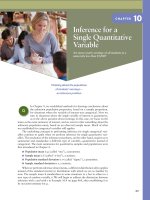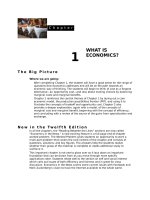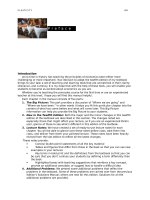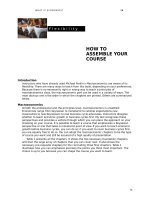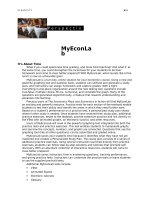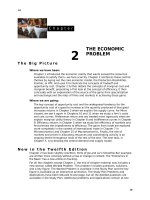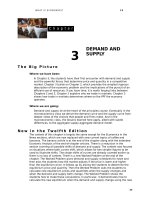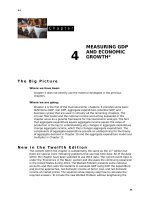The big picture marcoeconomics 12e parkin chapter 11
Bạn đang xem bản rút gọn của tài liệu. Xem và tải ngay bản đầy đủ của tài liệu tại đây (361.16 KB, 12 trang )
W H AT I S E C O N O M I C S ?
95
1
1
EXPENDITURE
MULTIPLIERS**
The Big Picture
Where we have been:
Chapter 11 uses the background provided in Chapters 4 and 10 to focus on
aggregate expenditure and aggregate demand. It builds on the division of GDP
into C + I + G + (X – M) explained in Chapter 4 and then derives the
aggregate demand curve previously used in Chapter 10.
Where we are going:
Chapter 11 examines the details of the AS-AD model by focusing on the factors
that determine the AD curve. The AD curve is important in all the core shortrun macroeconomic chapters. The material in this chapter is used in Chapters
12-14 on the business cycle, fiscal policy, and monetary policy.
N e w i n t h e Tw e l f t h E d i t i o n
The data in this chapter have been updated to reflect 2014 information. The
Economics In The News feature reports the BEA statistics for 2014 with economic
analysis using the Aggregate Expenditure model. The Mathematical Note now
includes a short exercise at the end. Using data on disposable income and
consumption expenditure, the Worked Problem shows the calculation and effect of
the multiplier. It also asks the students to use the multiplier to determine the
effect an increase in autonomous expenditure has on real GDP. To include the new
Worked Problem without lengthening the chapter, some problems have been
removed from the Study Plan Problem and Applications. These problems are in the
MyEconLab and are called Extra Problems.
95
Lecture Notes
Expenditure Multipliers
The Keynesian model focuses on the short run.
In the Keynesian model, business cycle fluctuations are driven by changes in the
components of aggregate expenditure, especially investment.
The multiplier effect describes the amplified effect on real GDP from changes in
expenditure.
Historical background. If you want to talk about Keynes and his contribution to
economics, this is probably the best place to do it.
The model, now generally called the aggregate expenditure model, presented in this
section is the essence of Keynes General Theory. According to Don Patinkin, a leading
historian of economic thought and Keynes scholar, the innovation of the General Theory
was to replace price with income (GDP) as the equilibrating variable. This version of the
model cannot be found in the General Theory, mainly because Keynes was writing before
the national income accounting system had been developed. So he made up his own
aggregates, based on employment and a money wage measure of the price level. But the
words and equations of the General Theory can be translated readily into the textbook
version of the model. This version of the model first appeared in The Elements of
Economics, a textbook authored by Lorie Tarshis published in 1947. It was popularized by
Paul Samuelson in the first edition of his celebrated text published in 1948.
The main difference between the Keynesian cross model of the 1940s and the aggregate
expenditure model of today is that from the 1940s through the mid-1960s, economists
believed that the fixed price level assumption was an acceptable (if not exactly accurate)
description of reality, so the model was seen as actually determining real GDP, and the
multiplier was seen as an empirically relevant phenomenon. In contrast, today, we see the
model as part of the aggregate demand story. The value of the model today—and it is
valuable today and not, as some people claim, eclipsed by the AS-AD model and irrelevant
—is that it explains the multiplier that translates a change in autonomous expenditure into
a shift of the AD curve and it explains the multiplier convergence process that pulls the
economy toward the AD curve. (When an unintended change in inventories occurs, the
economy is of the AD curve but moving toward it.)
I. Fixed Prices and Expenditure Plans
The Keynesian model applies to the very short run in which firms have fixed the prices of
their goods and services. As a result, the price level is fixed and so aggregate demand
determines real GDP.
Expenditure Plans
Aggregate planned expenditure is equal to planned consumption expenditure
plus planned investment plus planned government expenditure on goods and
services plus planned exports minus planned imports.
In the very short term, planned investment, planned government expenditure, and
planned exports are fixed. Planned consumption expenditure and planned imports
are not fixed, but depend on aggregate income. An increase in real GDP increases
aggregate expenditure and an increase in aggregate expenditure increases real GDP.
Consumption Function and Saving Function
Consumption expenditure and saving depend on the real interest rate, disposable
income, wealth, and expected future income. Disposable income is aggregate
income minus taxes plus transfer payments. The relationship between consumption
expenditure and disposable income, other things remaining the same, is called the
E X P E N D I T U R E M U LT I P L I E R S
consumption function. The relationship between saving and disposable income,
other things remaining the same, is called the saving function.
111
112
CHAPTER 11
The figure shows a consumption function.
Along the 45 degree line, consumption
equals disposable income. When the
consumption function is above the 45
degree line, there is dissaving. When the
consumption function is below the 45
degree line, there is saving.
The consumption expenditure when
disposable income is zero, $4 trillion in the
figure, is autonomous consumption.
Consumption expenditure in excess of this
amount is induced consumption.
The 45° line. Don’t assume that your students immediately understand the 45° line!
Spend a bit of time explaining how to “read” it. Fundamentally, it shows all points where x
= y. This line happens to be a 45° line when the scales along the x-axis and the y- axis are
the same. Then point out that the horizontal distance to a point along the x-axis equals the
vertical distance from that point to the 45° line. So at all points along the 45° line, x = y. If
you wish, you can go on to show the students how the x = y line changes its appearance if
we stretch or squeeze the scale on the y-axis holding the scale on the x-axis constant.
Emphasize that x and y can be anything. In the figure above, x is disposable income and y
is consumption expenditure; in the figure below, x is real GDP and y is aggregate planned
expenditure.
Marginal Propensities to Consume and Save
The marginal propensity to consume (MPC) is the fraction of a change in
disposable income that is consumed, C/YD. The MPC is the slope of the
consumption function, which is 0.67 in the figure.
The marginal propensity to save (MPS) is the fraction of a change in disposable
income that is saved, S/YD. The MPS is the slope of the saving function.
The sum of the MPC plus the MPS equals 1.0.
Marginal propensities. The text defines the MPC and MPS, and shows that they sum to
one because disposable income can only be consumed or saved. Students generally relate
to percentages better, so you can explain it as percent but stress that we use the decimal
number for analytical purposes.
Other Influences on Consumption Expenditure and Saving
A change in any other factor influencing consumption and saving besides disposable
income (such as the real interest rate, wealth, and expected future income) shifts the
consumption function and the saving function. An increase in wealth or expected future
income and a decrease in the real interest rate increases consumption—and shifts the
consumption function upward—and decreases saving—and shifts the saving function
downward.
The U.S. MPC is about 0.9. Since the 1960s, increases in expected future income and
wealth have shifted the consumption function upward.
E X P E N D I T U R E M U LT I P L I E R S
Consumption as a Function of Real GDP and the Import Function
For a given level of taxes and transfers, disposable income changes when real GDP
changes, so consumption also is a function of real GDP. We use this observation
when we derive the aggregate expenditure function.
Just as consumption of domestically produced goods and services depends on real
GDP, so do imports. The marginal propensity to import is the fraction of an
increase in real GDP that is spent on imports.
II. Real GDP with a Fixed Price Level
Real
GDP
(Y)
Consumpti
on
expenditur
e
(C)
Investme
nt
(I)
Governme
nt
expenditur
e
(G)
Export
s
(X)
Import
s
(M)
Aggregate
planned
expenditure
(AE=C+I+G+X
M)
0.8
0.9
1.0
1.1
14.4
15.2
16.0
17.8
(trillions of 2009 dollars)
14.0
15.0
16.0
17.0
10.2
11.1
12.0
12.9
2.0
2.0
2.0
2.0
2.0
2.0
2.0
2.0
1.0
1.0
1.0
1.0
Aggregate Planned Expenditure and Real GDP
Aggregate planned expenditure, AE, is the
sum of planned consumption expenditure
plus planned investment plus planned
government expenditure on goods and
services plus planned exports minus
planned imports. The above table shows
the calculation of an aggregate planned
expenditure schedule. The figure shows the
resulting AE curve.
Consumption expenditure minus imports
vary with real GDP and are induced
expenditure. The sum of investment,
government expenditures, and exports do
not vary with real GDP and are
autonomous expenditure. Consumption
expenditure and imports also have an
autonomous component.
Actual expenditure can differ from planned expenditure because firms do not always
sell what they plan to, in which case they have unplanned inventory investment. For
instance, a car that is manufactured but not immediately sold is part of that firm’s
actual inventory investment regardless of whether the firm planned to add it to
inventory or not.
Equilibrium Expenditure and Convergence to the Equilibrium
Equilibrium expenditure is the level of aggregate expenditure that occurs when
aggregate planned expenditure equals real GDP. In the figure, equilibrium
expenditure is $12 trillion.
If aggregate expenditure does not equal its equilibrium, forces lead to convergence.
For example, if real GDP exceeds aggregate planned expenditure, firms find their
113
114
CHAPTER 11
inventories are increasing more than planned. The unplanned inventory
accumulation leads firms to cut production so that real GDP decreases, which
decreases aggregate planned expenditures. Real GDP still exceeds aggregate
planned expenditure, but by less than before. The process continues until real GDP
equals aggregate planned expenditure so that there is no unplanned inventory
accumulation.
III. The Multiplier
The multiplier is the amount by which a change in autonomous expenditure is
magnified or multiplied to determine the change in equilibrium expenditure and real
GDP.
When there is an autonomous change in a component of expenditure such as
investment, additional changes in aggregate expenditure are set in motion. Because
of the feedback between real GDP and consumption expenditure, the total change in
real GDP is larger than the initial change in autonomous expenditure.
The multiplier effect operates for a decrease as well as an increase in autonomous
expenditure.
Work through an example of a change in government spending. Suppose there are no
taxes, no imports, no exports and the MPC is 0.9. If the government purchases $5 billion of
weapons from Nuc’s-R-US, what happens to that spending? Nuc’s has to pay all of its
employees, subcontractors and material suppliers among other costs. These costs to Nuc’s
turn into income (Y) for others (remind your students of the circular flow). These other
people are going to consume 90 percent of that income, $45 billion, at stores such as
JCPenney. Now JCPenney must pay its costs, which again turns into other people’s income,
of which 90 percent again gets spent again ($40.5 billion) and so on and so on and so on…
Explain to the students that we have a short-cut to explain this iterative process and
capture the total change in income (Y) from the change in government spending (G).
That short-cut is the multiplier, which shows that the change in GDP is given by GDP = 1/
(1 MPC) × G
Why is the Multiplier Greater Than 1?
An increase in autonomous expenditure increases real GDP and the increase in real GDP
induces an additional increase in aggregate expenditure (primarily an increase in
consumption expenditure). Each additional increase in aggregate expenditure increases
real GDP further, leading to yet further increases in aggregate expenditure. The process
converges because the increase in aggregate expenditure is smaller at each step of the
process.
The Multiplier and the Marginal Propensities to Consume and Save
The change in real GDP can be divided into the change in induced expenditure plus
the change in autonomous expenditure, Y = N + A, where Y is real GDP, N is
induced expenditures, and A is autonomous expenditure. The slope of the AE curve
= N÷Y, so N = (slope of AE curve) Y. Using this equality in the previous
formula shows Y = (slope of AE curve) Y + A. Solving for the change in GDP, Y,
gives Y =
1
A. This last result shows that the multiplier
1 slope of the AE curve
E X P E N D I T U R E M U LT I P L I E R S
equals
1
. In the previous figure, the slope of the AE curve is
1 slope of the AE curve
0.8, so the multiplier is 5.0.
If there are no imports or income taxes, the slope of AE curve equals the MPC so the
multiplier equals
1
1
or, equivalently,
.
1 MPC
MPS
The size of the multiplier depends on the MPC and the MPS. The smaller the MPC or,
equivalently, the larger the MPS, the smaller the increase in expenditure at each
step of the multiplier process and so the smaller the multiplier.
The basic idea and practice. Students need quite a lot of practice using multipliers. One
good problem involves working out the effects on consumption as well as on GDP of a
change in investment (when the price level is fixed). The best way to present this problem
to the students seems to be sequentially. Begin by giving them the data necessary to
deduce how real GDP changes from an increase in investment. Tell them there is no foreign
trade, so that there are no exports or imports, and no income taxes. Tell them that the
marginal propensity to consume is b (pick any valid number you like), and that investment
has changed by I (pick any valid number you like). Then, after the students have
computed the change in GDP, ask them what the change in consumption expenditure is.
Review their attempts to answer this question as follows: The change in GDP, Y, is given
by the equation:
Y = C + I. Given I from the initial statement of the problem and Y from the first set of
calculations, the students can readily calculate C. Focusing the students’ attention on the
change in consumption is important because it reinforces the point that a change in
autonomous expenditure (investment in this example) leads to an induced change in
consumption expenditure and that this increase in consumption expenditure is the source
of the multiplier.
An Economics in Action detail analyzes the multiplier in the Great Depression. The analysis
concludes that the multiplier during that episode in history equaled 1.6.
The Efect of Imports and Income Taxes on the Multiplier; Business Cycle Turning
Points
Imports and income taxes both mean that the increase in expenditure on domestic
production will be smaller at each step of the multiplier process and so the multiplier
is smaller.
An unexpected decrease in autonomous expenditure is signaled by a buildup of
unplanned inventories. The buildup in inventories sets the multiplier process in
motion that decreases aggregate expenditure and real GDP so that a recession
follows.
An unexpected increase in autonomous expenditure is signaled by an unwanted
depletion of inventories. The depletion in inventories sets the multiplier process in
motion and an expansion follows.
The idea that prices are fixed, even in the very short run, is controversial in economics.
However, the fact that changes in inventories have long been a good leading indicator of
business cycles is less controversial.
IV. The Multiplier and the Price Level
In the short run, when firms find their inventories changing in an unexpected fashion, they
change their production not their prices. But eventually they also change prices. To study
115
116
CHAPTER 11
the determination of the price level and real GDP the AS-AD model must be used. The AD
curve is related to the AE curve.
The Aggregate Expenditure Curve and the Aggregate Demand Curve
The AE curve is the relationship between aggregate planned expenditures and real
GDP, all other influences (such as the price level) remaining the same. The AD curve
is the relationship between the aggregate quantity of goods and services demanded
and the price level. When the price level changes, the AE curve shifts and there is a
movement along the AD curve.
A change in the price level has two effects on consumption expenditure:
Wealth Effect: A rise in the price level decreases the purchasing power of
consumers’ real wealth, which decreases their consumption expenditures.
Substitution Effects: A rise in the price level makes purchasing today more
expensive relative to the future (an intertemporal substitution effect). It also
makes U.S. goods and services more expensive relative to imports (an
international substitution effect).
The multiplier and the price level: Emphasize the key point of this section: That the AE
model and the multiplier tell us how far the AD curve shifts when autonomous expenditure
changes. It is through the multiplier process that expenditure and GDP respond to
unplanned changes in inventories. I like to draw out the model with AE curve on top and
the AD and AS curves on the bottom. Then:
‡ Shift AE curve upward by change in G.
‡ Show the larger change in Y due to multiplier.
‡ Shift the AD curve rightward by an amount equal to the change in Y holding the price
level constant.
Ask the students, “Will the economy get the full change in Y?” They will see that in that the
upward sloping SAS curve means that there is an increase in the price level, lowering the
multiplier effect.
‡ Next, show them the price level effect in the AE graph (a smaller downward shift in the
AE curve).
Now ask them, “How big is the multiplier in the long run?” You should be able to get a few
to mumble “Zero”.
So, tell them the conclusion: There is no multiplier in the long run! If the long run is not so
long, then it is questionable to increase G in order to increase Y. Students appreciate
learning about the tension in economics surrounding this issue since it relates well with
politics too.
The mechanics of the relationship between the AE and AD curves. Students need a
lot of help and clear explanation of the mechanics of the link between these two curves.
Here’s what to stress:
1. The AE curve shows how aggregate planned expenditure depends on real GDP (through
the effects of disposable income), other things remaining the same.
2. The AD curve shows how equilibrium aggregate expenditure depends on the price level,
other things remaining the same.
The next two points are really hard for students:
3. A change in the price level changes autonomous expenditure, which shifts the AE
curve, generates a new level of equilibrium expenditure, and creates a new point on the
AD curve.
4. A change in autonomous expenditure at a given price level shifts the AE curve,
generates a new level of equilibrium expenditure, and shifts the AD curve by an
amount equal to the change in autonomous expenditure multiplied by the multiplier.
E X P E N D I T U R E M U LT I P L I E R S
The wealth effect and the substitution effects show that a rise in the price level
decreases consumption expenditure. So, as shown in the figure below to the left, a
rise in the price level from 120 to 140 decreases aggregate planned expenditure and
shifts the AE curve downward from AE0 to AE 1. In the figure, equilibrium expenditure
decreases to $14 trillion.
The diagram to the right, below, shows that when the price level rises from 120 to
140, there is a movement along the AD curve from point a to point b. The aggregate
quantity of real GDP demanded decreases from $16 trillion (which is the initial
equilibrium expenditure in the AE diagram to the left) to $14 trillion (which is the
new equilibrium expenditure along AE1 in the AE diagram to the left).
If the AE curve shifts for any reason other than a change in the price level, then the
AD curve also shifts. For instance, an increase in autonomous expenditures shifts the
AE curve upward and increases equilibrium expenditure by a multiplied amount. In
this case, the AD curve shifts rightward and the amount of the rightward shift is
equal to the increase in equilibrium expenditure.
In the figure to the right, autonomous
expenditure increases so that the AD
curve shifts rightward. The multiplied
increase in autonomous expenditure has
created a $2 trillion increase in
equilibrium expenditure, so the AD curve
shifts rightward by $2 trillion (which
equals the length of the double headed
arrow) from AD0 to AD1.
Equilibrium Real GDP and the Price Level
Aggregate demand and short-run
aggregate supply determine the
equilibrium price level and real GDP.
In the short run:
An increase in aggregate demand
raises the price level and increases real GDP. In the figure to the right, the
increase in aggregate demand and rightward shift of the aggregate demand
curve from AD0 to AD1 creates a movement from point a to point b so that the
price level rises from 120 to 130 and real GDP increases from $13 trillion to $14
trillion.
117
118
CHAPTER 11
In
The increase in real GDP ($1 trillion) is less than the initial increase in equilibrium
expenditure ($2 trillion) because the rise in the price level decreases aggregate
planned expenditure. In terms of the AE curve, the increase in the price level
shifts the AE curve downward.
Because the actual increase in real GDP is less than the initial increase in
equilibrium expenditure, the multiplier is smaller once price level effects are
taken into account. The more that the price level changes (that is, the steeper
the SAS curve), the smaller the multiplier in the short run.
the long run:
Real GDP exceeds potential GDP and employment exceeds full employment. So
the money wage rate rises, which decreases the short-run aggregate supply and
shifts the SAS curve leftward. The economy moves along the AD curve so that the
price level rises and real GDP decreases.
In the figure above, the economy moves along AD1 from point b to point c. (The
shift in the SAS curve is not illustrated in order to simplify the figure.) The price
level rises from 130 to 140 and real GDP decreases from $14 trillion back to
potential GDP of $13 trillion.
The further increase in the price level further decreases aggregate planned
expenditure. In terms of the AE curve, the AE curve shifts downward and
eventually returns to its initial level. As a result, the long-run multiplier is equal
to zero.
It is important to emphasize that the aggregate expenditure model is not without
connection to the AS-AD model. Point out to the students that the AE model provides the
underpinnings for the AD curve in the AS-AD model used throughout macroeconomics.
That is, the students can now understand why the AD curve shifts, why it is downward
sloping, and why changes in the price level lead to movements along the AD curve.
It may be a good time to remind students that, just as the Keynesian AE model provides
underpinnings for the AD curve, the labor market/aggregate production function model
discussed in Chapter 6 provides underpinnings for the long-run aggregate supply curve.
Thus, the mechanics of the model have not changed, but the students now have a deeper
understanding of the forces behind those mechanics.
The Economics in the News section studies expenditure changes in the 2014 expansion. It
analyzes the growth during the second quarter in terms of the aggregate expenditure
model. It focuses on which changes in autonomous expenditure were responsible for
increasing aggregate expenditure and hence real GDP.
E X P E N D I T U R E M U LT I P L I E R S
Additional Problems
1. a. How is it possible for households to have a negative savings rate? What has
caused this negative household savings rate?
b. Is this negative household savings rate sustainable in the long-run?
2.
Why is the multiplier only a short-run influence on GDP?
3.
When the economy is in a recession and the government enacts a stimulus
package, why might a low MPS be good in the short-run in this situation, but
not in the long-run?
Solutions to Additional Problems
1. a. Households can have a negative saving rate by borrowing. Households increase their
borrowing if their wealth rises, if the real interest rate falls, or if their expected future
income rises. Any or all of these factors could lead to a negative saving rate.
b. A negative saving rate is not sustainable in the long run. In the long run the saving
rate must be positive, if for no other reason than to repay the borrowing.
2.
The multiplier has only a short-run influence on real GDP because in the long run the
money wage rate changes. The change in the money wage rate affects short-run
aggregate supply and lowers the price level. The fall in the price level restores
aggregate planned expenditure back to its initial level and moves the economy back
to its long-run equilibrium. The long-run change in aggregate expenditure offsets the
initial multiplier effect on real GDP.
3.
In the short run, the fear is that a stimulus package while not have enough force to
move the economy back to potential GDP. In this situation a small MPS is desirable
because it means more spending from any increase in disposable income. However in
the long run the economy needs saving to help it grow. Saving in the United States is
quite low so in the long run a small value for the MPS is not helpful.
Additional Discussion Questions
11. Why is there a “two-way” link between consumption and GDP?
Consumption is part of aggregate expenditure so an increase in consumption
increases aggregate expenditure and hence increases GDP. Simultaneously
GDP is equal to aggregate income so an increase in GDP increases disposable
income and hence increases consumption.
12. How does an increase in disposable income affect the consumption
function? An increase in expected future income? An increase in
disposable income leads to a movement upward along the consumption
function. An increase in expected future income shifts the consumption
function upward.
13. If the consumption function shifts upward, what happens to the
saving function? Why? If the consumption function shifts upward, the saving
function shifts downward. The upward shift in the consumption function means
that for each level of disposable income consumption increases. If
consumption increases at each level of disposable income, saving necessarily
must decrease. The decrease in saving at each level of disposable income
means that the saving function shifts downward.
119
120
CHAPTER 11
14. When is actual aggregate expenditure different from planned
aggregate expenditure? What happens to bring the two back to
equality? Actual aggregate expenditure differs from planned aggregate
expenditure whenever the economy is not at its equilibrium. These amounts
differ as a result of unplanned inventory changes. Take, for instance, the
situation when actual aggregate expenditure exceeds equilibrium expenditure.
In this case the 45° line, which shows actual aggregate expenditure, lies above
the aggregate planned expenditure curve, which shows planned aggregate
expenditure. Hence actual aggregate expenditure exceeds planned aggregate
expenditure. In this situation actual inventory change—which is the measure
of inventory change that is included in actual aggregate expenditure—exceeds
planned inventory change—which is the measure of inventory change that is
included in planned aggregate expenditure. Because actual inventory change
exceeds the planned inventory change, firms are finding that their inventories
are accumulating in an undesired fashion. They respond to this state of affairs
by decreasing their production. As production decreases, real GDP and hence
aggregate expenditure decrease until aggregate expenditure eventually
equals equilibrium expenditure.
15. Explain why income taxes reduce the size of the expenditure
multiplier. The expenditure multiplier results because an increase in
autonomous expenditure increases disposable income and induces additional
consumption expenditure. In turn the additional consumption expenditure
increases disposable income once again, which then induces still additional
consumption expenditure. The result that expenditure increases because of
the initial increase in autonomous expenditure and then also because of the
induced increase in consumption expenditure is why the expenditure multiplier
exists. Income taxes decrease the size of the increase in disposable income
that results from an increase in expenditure. Therefore the resulting (induced)
increase in consumption expenditure is smaller so that the overall expenditure
multiplier is smaller.
16. Explain the difference between the aggregate expenditure curve and
the aggregate demand curve. The aggregate expenditure curve shows how
aggregate expenditure changes when GDP changes. The aggregate demand
curve shows how (equilibrium) expenditure and GDP change when the price
level changes.
17. Suppose that exports (autonomously) increase. What happens to the
aggregate expenditure curve? The equilibrium level of aggregate
expenditure? The aggregate demand curve? The aggregate expenditure
curve shifts upward. Through the multiplier process the equilibrium level of
aggregate expenditure increases. The aggregate demand curve shifts
rightward by an amount equal to the increase in equilibrium expenditure.

